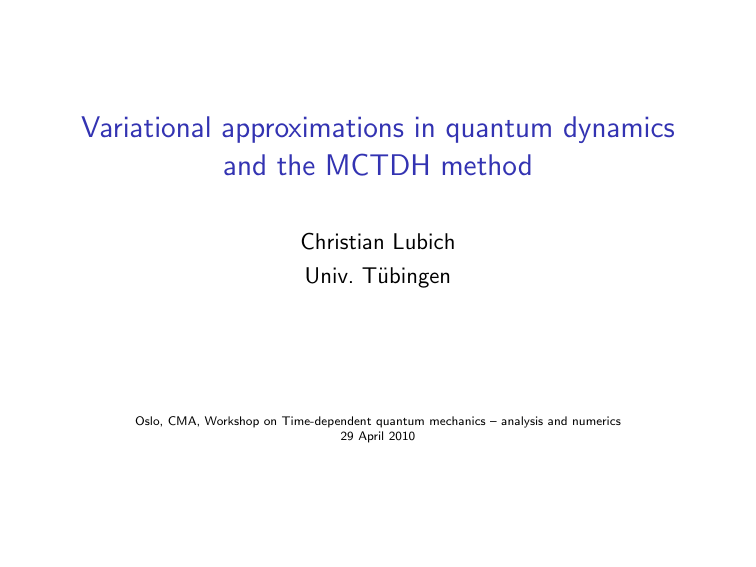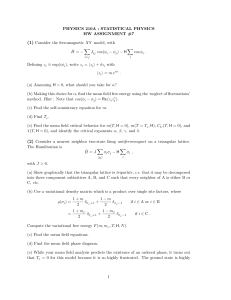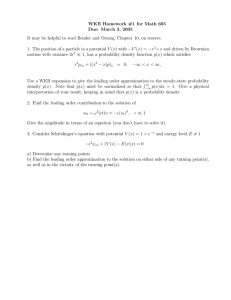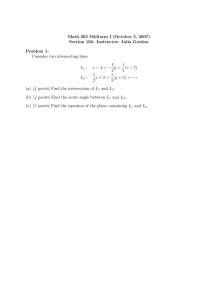Variational approximations in quantum dynamics and the MCTDH method Christian Lubich Univ. T¨
advertisement

Variational approximations in quantum dynamics and the MCTDH method Christian Lubich Univ. Tübingen Oslo, CMA, Workshop on Time-dependent quantum mechanics – analysis and numerics 29 April 2010 Setting Full quantum dynamics: Schrödinger equation i ψ̇ = Hψ, ψ = ψ(x1 , . . . , xN , t) ↑ Intermediate models: via Dirac–Frenkel variational principle Born–Oppenheimer, MCTDH, Gaussian wavepackets, . . . ↓ Classical molecular dynamics: Newtonian eqs. of motion M ẍ = −∇V (x), x = (x1 (t), . . . , xN (t)) Time-dependent Schrödinger equation i N-particle wavefunction: ∂ψ = Hψ ∂t ψ = ψ(x, t) for x = (x1 , . . . , xN ) ∈ R3N , xn ∈ R3 , t > 0 Hamiltonian operator: H = T + V with the kinetic and potential energy operators N X 1 ∆x T =− 2mj j j=1 high-dimensional linear PDE and V = V (x) (smooth and bounded) Outline The Dirac–Frenkel variational approximation principle The MCTDH method, or dynamical low-rank approximation Variational splitting for MCTDH Modelling error of MCTDH Outline The Dirac–Frenkel variational approximation principle The MCTDH method, or dynamical low-rank approximation Variational splitting for MCTDH Modelling error of MCTDH Dirac-Frenkel principle: abstract formulation M ⊂ L2 (R3N ) approximation manifold Tu M tangent space at u ∈ M, complex linear approximate wavefunction u = u(·, t) ∈ M determined from hi u̇ − Hu, v i = 0 for all v ∈ Tu M Galerkin method on a state-dependent approximation space Dirac 1930, Frenkel 1934 (TDHF) Orthogonal projection Re hu̇ − 1i Hu, v i = 0 for all v ∈ Tu M equivalent to minimum defect condition: determine approximation t 7→ u(t) ∈ M such that u̇ = ϑ ∈ Tu M with kϑ − 1i Huk = min! orthogonal projection u̇ = P(u) 1i Hu Frenkel 1934 → Dirac Cover illustration: tangent space projection u̇ = P(u) 1i Hu 2008 Symplectic projection Im hu̇ − 1i Hu, v i = 0 • symplectic 2-form on L2 (R3N ): • Hamiltonian function: for all v ∈ Tu M ω(ξ, η) = −2 Im hξ, ηi H(u) = hu, Hui Hamiltonian system on the manifold M: ω(u̇, v ) = dH(u)v for all v ∈ Tu M Consequences: I energy conservation: H(u(t)) = Const. I symplecticity of the flow: for ξ(t), η(t) tangent vectors propagated by the linearized flow along u(t), ω(ξ(t), η(t)) = Const. Approximation properties u(t) ≈ ψ(t) ? Approximation error I A posteriori error bound Z ku(t) − ψ(t)k ≤ t dist 0 I 1 i Hu(τ ), Tu(τ ) M dτ Quasi-optimality ku(t) − ψ(t)k ≤ d(t) + Ce cκt Z t d(τ ) dτ 0 with d(t) = dist(ψ(t), M) the best-approximation error, κ bound of the curvature of M L. 2005 Outline The Dirac–Frenkel variational approximation principle The MCTDH method, or dynamical low-rank approximation Variational splitting for MCTDH Modelling error of MCTDH MCTDH Multi-Configuration Time-Dependent Hartree method Time-dependent Hartree method Hartree product: ψ(x1 , . . . , xN , t) ≈ φ(1) (x1 , t) · . . . · φ(N) (xN , t) Equations of motion for single-particle functions φ(n) (xn , t) by Dirac–Frenkel reduction to M = φ(1) ⊗ . . . ⊗ φ(N) φ(n) ∈ L2 (R3 ) separation of variables, rank-1 approximation MCTDH Multi-Configuration Time-Dependent Hartree method Approximate by linear combination of Hartree products ψ(x, t) ≈ r1 X j1 =1 ... rN X (1) (N) aj1 ...jN (t) φj1 (x1 , t) · . . . · φjN (xN , t) jN =1 (n) (n) I mutually orthogonal single-particle functions φ1 , . . . , φrn I core tensor (aj1 ...jN ) of full multilinear rank (r1 , . . . , rN ) Tucker format, not canonical format also hierarchical Tucker format H.D. Meyer et al. 1990 - , MCTDH book 2009 MCTDH equations of motion from Dirac–Frenkel variational principle on MCTDH manifold: coupled system of ODEs and low-dimensional nonlinear PDEs i iρ(n) with ΦJ (x, t) = QN daJ dt ∂φ(n) ∂t n=1 = X hΦJ | H | ΦL i aL L = (I − P (n) ) hHi¬xn φ(n) (n) φjn (xn , t) for multi-indices J = (j1 , . . . , jN ) Meyer, Manthe & Cederbaum 1990 existence and regularity: Koch & L. 2007 Outline The Dirac–Frenkel variational approximation principle The MCTDH method, or dynamical low-rank approximation Variational splitting for MCTDH Modelling error of MCTDH Variational splitting: the formal game variational approximation: H = T + V hi u̇ − Hu, v i = 0 for all v ∈ Tu M time step un → un+1 via − 1. half-step with V : un+1/2 solution at ∆t/2 of hi u̇ − V u, v i = 0 for all v ∈ Tu M + 2. full step with T : un+1/2 solution at ∆t of hi u̇ − T u, v i = 0 for all v ∈ Tu M 3. half-step with V : un+1 solution at ∆t/2 of hi u̇ − V u, v i = 0 for all v ∈ Tu M Variational splitting for MCTDH I Step with T : since Tu ∈ Tu M for u ∈ M, integration step with T decouples into ȧJ = 0 and (k) i ∂φj ∂t (xk , t) = − 1 (k) ∆xk φj (xk , t) 2mk low-dimensional free Schrödinger equations → FFT I Step with V : MCTDH for Hamiltonian V instead of H → larger time steps independently of the space discretization explicit, unconditionally stable scheme L. 2004 Error of variational splitting for MCTDH second order error bound kun − u(tn )k ≤ C ∆t 2 max ku(t)kH 2 same as for Strang splitting for the linear Schrödinger equation basic tool: Lie-commutator bounds for vector fields corresponding to T and V Outline The Dirac–Frenkel variational approximation principle The MCTDH method, or dynamical low-rank approximation Variational splitting for MCTDH Modelling error of MCTDH Convergence of MCTDH to Schrödinger solution??? Naive expectation: Taking more and more terms in the linear combination of Hartree products yields an ever better accuracy Obstructions: I approximation properties of basis of Hartree products ΦJ (·, t)? I ill-conditioned coefficient tensor (aJ ) ↔ ill-conditioned density matrices ρ(n) = A(n) A∗(n) Quasi-optimality of variational approximation u(t) MCTDH approximation, ψ(t) exact wave function MCTDH error bounded by best-approximation error: Z t cκt ku(t) − ψ(t)k ≤ d(t) + Cκ e d(τ ) dτ 0 with d(t) = dist(ψ(t), M) and κ curvature of manifold M but κ ∼ cond(ρ(n) )1/2 → ∞ as number of configurations → ∞ L. 2005 Objectives I error bounds in the case of ill-conditioned density matrices I convergence as number of configurations → ∞ under appropriate assumptions Conte & L., M2AN 2010 Approximability assumption Exact wavefunction can be written as ψ(t) = v (t) + e(t) where v (t) ∈ M has small defect: ∂v i (·, t) − Hv (·, t) ≤ ε ∂t Small error e(t) and small defect (ε) for some linear combination of Hartree products Assumptions on the coefficient tensor B(n) (t) nth unfolding of coefficient tensor (bj1 ...jN (t)) of v (t) ∈ M, for n = 1, . . . , N I Bound of the pseudo-inverse (large: small δ!): † kB(n) (t)k2 = I 1 ≤ δ −1 σrn (B(n) (t)) Small time derivatives of the coefficient tensor in components that correspond to small singular values: † B(n) (t) Ḃ(n) (t) ≤ c, 2 Error bound ku(t) − ψ(t)k ≤ ke(t)k + 2tε for t = O(δ/ε) Bound independent of δ (ill-conditioning) for fixed rank, can achieve δ ∼ ε by perturbing v (t): t = O(1) Convergence: if we assume δ ∼ ε, we can admit arbitrary number of configurations: ε → 0 Proof of the error bound use estimates for the tangent space projection P(u) to show a quadratic differential inequality C d ku − v k ≤ ku − v k2 + ε dt δ Summary I MCTDH: a method to make the high dimensionality of molecular quantum dynamics tractable I theoretical underpinning of this “highly efficient method” I understanding the mechanism and possible failures of the MCTDH method in a novel error analysis




